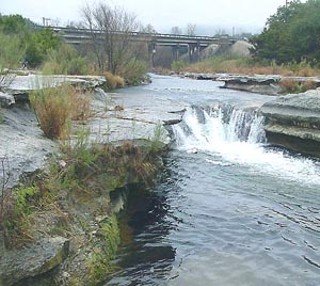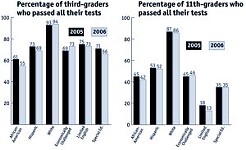Keeping Austin Wild
As the population swells, officials and activists look for ways to preserve open space
By Rachel Proctor May, Fri., July 8, 2005

Summer in Texas is a good time to think about open spaces, a process best accomplished by visiting one. On a recent sweltering day, I wandered down the Scottish Woods entrance to the western edge of the Barton Creek greenbelt, and descended the long, rocky slope known to mountain bikers far and wide as the Hill of Life. It was hot. About halfway down, I passed a biker who had propped himself up against a tree to wheeze. "Hill – wheeze wheeze – of life," he gasped. "Sure doesn't feel like it."
Down in the creek, a large bearded man with three peppy terriers lay belly-up at the head of a small falls. A group of teenagers clustered in the deepest part of the shady pool to gossip and flirt. I sat for a while below the waterfall, and when I got out saw a four-foot snake slithering along the rocky creekbed.
"Holy shit!" I said.
I was not alone in my delight. A foursome of twentysomethings crowded around the water's edge, pointing and shouting. With uncertain but ample enthusiasm, the snake was declared a water moccasin – "The most poisonous kind of snake there is!" – and a shirtless young man grabbed a stick and began a vigorous effort to get the snake to "come out and fight." The effort continued, loudly, for several minutes; when the snake did emerge, it made a slithery beeline toward the reeds on the far side of the creek. The snake was declared a pussy, and everyone's attention turned to the primary task at hand: sitting neck-deep in the water and letting it flow on by.
Keeping wild areas wild is good for a lot of things: protecting the water, preserving endangered species, and (too often forgotten in the political debates) having the chance now and then to chase a snake with a big old stick. In the coming months, three new efforts are poised to unfold that will bring the issue of open space acquisition front and center. The city and county are each developing bond proposals that may include money to buy parks or preserves. On an entirely different front, the Save Our Springs Alliance has announced its intention to sue the Texas Department of Transportation and other highway entities for inadequately assessing the environmental impacts of the planned expansion of U.S. 290 into the Hill Country. On the surface, that sounds like environmental business as usual, but as part of the suit, the plaintiffs are pushing for mitigation funds to buy open spaces – an innovative strategy that may look like a long shot, but is not entirely without precedent.
Urban planners project that Central Texas, which has consistently doubled in population every couple of decades, will attract around 1.25 million new residents in the next 20 to 40 years. No matter how one feels about Austin's current supply of hiking trails, parks, and pools, that growth means a whole lot more bodies in the swimmin' hole. As the region grapples with implementing its Envision Central Texas plan of accommodating the growth in a less sprawling way, these open space efforts will go a long way toward leaving plenty of green space for everyone.
Green Bondage
The earliest opportunity Central Texans will have to debate the open space issue is during the lead-up to the Travis County bond election, under consideration for November. It's hard to overestimate the role the county can play from here on out in protecting open spaces, particularly in the Barton Springs watershed. Of the 370 square miles of the watershed, only 28% is in the city of Austin's jurisdiction (about 27% of that city acreage is already in some sort of park or preserve, and about 39% remains undeveloped). Outside the city's jurisdiction, in Travis and Hays counties, 81% of the land is undeveloped, and only 4% is in parks or preserves.
County commissioners have yet to set a date – or officially decide whether there even will be a bond election. But, a citizens bond advisory committee is meeting, and trying to whittle down a wish list far more expensive than the $100 million that would keep the county's tax rate the same. "The bond committee's faced with the really difficult task of trying to pare over $400 million worth of projects down to optimally $100 million," said Perry Lorenz, who serves on the CBAC. The list of proposed projects includes $45 million for seven parks projects, including $16 million for two open space projects (acquiring 350 acres for a planned Onion Creek Greenway and water conservation lands in the southwest). An additional $6.5 million for improvements to a southwest regional park would include some land acquisition. However, other estimated needs include $80 million for jails, $235 million for roads, and $80 million for drainage and floodplain issues – inevitably pitting advocates of "purely environmental" initiatives against defenders of "basic services."
Even if county commissioners decide to put all $16 million of open space into the bond package voters will be asked to approve, conservationists would like to see more. In a June 3 progress report, the subcommittee asked the commissioners to also consider placing on the ballot a stand-alone measure to fund open space acquisition. Conservation groups including the Trust for Public Lands, the Hill Country Conservancy, and the Nature Conservancy are collaborating on a set of surveys to see what kind of open space projects the public would both enjoy having and be willing to pay for. "I've heard different people suggest different numbers," said George Cofer of the Hill Country Conservancy. "Twenty-five million has a nice ring to it. I think again it's going to be: What is the list of green space and trail projects that the voters want to see funded, and is that a $15 million list or a $50 million list?"
While finding landowners willing to sell or grant conservation easements is often portrayed as a challenge – and indeed, negotiations can be quite sensitive – Travis Co. environmental specialist Kevin Connally says that if the funds materialize, he could put them to immediate good use. "Right now, I have more willing sellers than I have funds to spend, so we have to be careful and strategic about what lands we buy."
Part of that strategy could involve close collaboration with the city, which is also in the early stages of its own bond process, to plan out purchases in a way that will get what Cofer describes as "the most bang for your buck." In other words, hitting the trail is that much nicer if you have a great, big place to wander around in – something Texas doesn't exactly have in abundance. (Indeed, compared to the amount of public lands nationwide, the amount of public space in the "everything's bigger" state is downright puny. Just 5% of Texas is publicly owned, compared to one-third of the land nationwide and a good 50% in much of the West.) Cofer suggested the 24,000-acre Balcones Canyonlands preserve, parts of which are owned and managed by the city, county, and a jumble of other entities, as a model for how that might work.
The advisory committee charged with developing the Austin bond proposal (anticipated for a vote some time next year), is barely out of the starting gate. Committee members face the same daunting task, on an even larger scale: paring down $769 million of needs to the $279 million that would maintain the city's current tax rate. The city's broad range of estimated needs include a possible $50 million for land acquisition, which must compete with other worthy goals such as drainage and transportation infrastructure, facilities upgrades, a new central library, and affordable housing initiatives.

Plus, deciding where to spend any open space dollars will not be easy. Both the city and county will have to balance the need to protect habitat and provide room to ramble on both the east and west sides, within the long-standing assumption that southwest land, because it is over the Edwards Aquifer, is the most important to protect. Rodney Ahart, who serves on the drainage and open spaces subcommittee of the city's bond effort, says parkland equity is something that's on the mind of all committee members. "We do have to protect our aquifer and water source, but open space is a significant part of the city's attractiveness and livability," he said. "That's something we have to assure throughout the city."
For Kevin Anderson, who oversees the Center for Environmental Research at Hornsby Bend on the Colorado River in southeast Austin, the perception that the southwest is a uniquely sensitive environment is an oversimplification. The Blacklands Prairie ecosystem, bits of which can be found in northeastern Travis County, is down to about .004% of its original range – all told, perhaps a few thousand acres exist in the whole central United States. And impervious cover – the hallmark of development – is just as bad for east Austin creeks as it is for the Edwards Aquifer. "In the city of Austin, our most erodable creeks are here on the Eastside," he said. "As you increase impervious cover, you increase flows in the creeks and have problems with erosion."
Meanwhile, as city and county voters start mulling over how to prioritize bond funds that are already in short supply, the SOS Alliance is looking into a different way to secure open spaces.
A Concrete Trade
Roads and related infrastructure are the necessary impetus for much real estate speculation and consequent development, and they add inevitably to the feasibility of even farther-out developments that, in turn, eat up open space. Central Texas will soon see new roads galore: CAMPO's 25-year plan includes about $22 billion of pavement, including $1.5 billion of roads in the Barton Springs watershed. Eyeing this cash cow, and the concrete landscape it has the potential to create, SOS has made what at first seems like a bold suggestion: How about using part of the accumulating piles of road-building money to mitigate the impacts of new highways? (To put the numbers in perspective, the group suggests that just $200 million would be enough to buy all of the roughly 15,000 acres currently slated for development in the Hill Country – although that's only a small fraction of the total private acreage out there.)
It may seem bold, but highway mitigation in the form of open-space acquisition is not a new idea. For example, TxDOT makes up for road construction in marshy areas by buying and adding to "wetlands banks." "I know we've done wetlands mitigation to a considerable degree down on the coast," said TxDOT's Austin division spokesman John Hurt. "By Beaumont, we acquired an entire swamp."
The emphasis is on wetlands protection because that's what the federal Clean Water Act requires – in parts of the country that don't have lovely karst aquifers, water-quality concerns often center around the flooding and water degradation associated with wetlands destruction. CWA rules don't apply out in the Hill Country, where the land is usually far from wet, so TxDOT mitigates the environmental impacts of highways through structured controls required under the Edwards Aquifer rules overseen by the Texas Commission on Environmental Quality. The rules' goal is to reduce the total suspended solids in stormwater by 80% – TSS is the silt that gunks up the aquifer, endangers aquatic life, and facilitates erosion when it flows off impervious pavement at high speeds. Local environmentalists have long complained that emphasis on TSS ignores other kinds of pollutants, such as petroleum by-products, and it also fails to take into account the long-term effects of a road's facilitation of further development. A December 2004 article in the journal Fisheries, for example, estimated that the majority of a road's total impacts come after construction. "The extensive and serious impacts of post-construction maintenance and of subsequent urban development along roads typically are excluded from agency decisions about building new roads. Thus, direct, localized, or acute impacts are emphasized whereas indirect, dispersed, or chronic impacts are neglected," wrote authors Paul Angermeier, et al.
Responding to a question posed by then Council Member Daryl Slusher, CAMPO recently researched whether the possibility existed to go further by using federal transportation dollars to mitigate the overall, long-term effects of new roads in sensitive environmental areas. CAMPO replied that such use of funds would be possible within the context of a statewide habitat restoration or preservation plan, and would have to be part of a mitigation effort on a federally funded road project.
On the one hand, that's good news for environmentalists. However, Mike Leary of the Texas division of the Federal Highway Administration said that mitigation plans focus on direct impacts – such as replacing wetlands that are to be paved over – as opposed to the more broad understanding of the concept. "I don't think we've been involved in buying open space in compensation for new or widened roadway. Our mitigation is for the direct impact of the roadway," he said.
Still, SOS is hoping to spur exploration into the issue. One event that may bring it into public discussion is a new lawsuit the group has announced its intention to file against TxDOT, the U.S. Fish and Wildlife Service, and the FHWA for failing to adequately assess the impacts of the planned expansion of Highway 290 through Oak Hill from four lanes to six, with four to six lanes of frontage road. In a June 13 letter of intent to sue, the group explained that TxDOT failed to conduct a thorough biological assessment as required by the Endangered Species Act, and that FWS let them get away with it.
Here's how it works: Any time a highway crosses critical habitat for endangered species, TxDOT must develop an environmental assessment of its impacts, and Fish and Wildlife, the federal agency responsible for ESA enforcement, must sign off on the assessment. In its analysis of the 290 project, TxDOT said the road would have a beneficial impact on water quality (and by extension on endangered salamanders) because the storm-water controls planned for the new Highway 290, plus the retrofitting it will add to the section of 290 completed in 1997, will reduce the TSS load going into Williamson Creek by 36%.
FWS initially rejected this claim. "The effect determination should be made based upon the remaining TSS and other pollutants, not on the fact that the proposed project is an improvement over the status quo," wrote FWS supervisor Bob Pine in a letter dated March 9, 2005. By April 4, however, FWS had backed down, and Pine sent a letter concurring with TxDOT's opinion that the highway would not likely adversely impact the Barton Springs salamander. This, says SOS lawyer John Fritschie, is unacceptable. "We really do feel that a full formal consultation, resulting in a biological opinion with far more extensive mitigation, is required for that project," he said.
As part of the intent-to-sue letter, then, SOS called on CAMPO, TxDOT, FHWA, FWS, and the city of Austin to not only conduct a more thorough analysis of the impacts, but to look into using federal highway money in conjunction with local dollars (perhaps the bond) and other federal dollars (such as ESA recovery funds) to "carry out an ambitious program for the conservation of the health of the Barton Springs Aquifer through land acquisition." TxDOT spokesman John Hurt declined to comment on the looming suit, since he has seen no legal filings. But he did say that TxDOT "stands behind the science" in the agency's biological assessment.
SOS and Sierra Club activist Dick Kallerman expects that any lawsuit will be a tough fight. "We've had very little success having TxDOT do anything but their agenda, and their agenda is roads," he said.
The agenda of many in central Texas, however, is finding ways to preserve land for the future, in whatever way possible. No matter how the public may feel about salamanders per se, surveys – such as a 2002 survey conducted by Texas Tech – have shown that more and bigger parks is an idea with broad appeal in Texas.
At recent hearings held by the county bond advisory committee to get feedback on community priorities, George Cofer said he was overwhelmed by the number of people who showed up to plead for open spaces. "Somebody's done a good job of turning out the troops," he said. "Or maybe that's been a groundswell. I can't take credit for it." Of course, the debate over what county residents "want" and "need" will no doubt be vigorous. Still, as the mountain bikers and climbers who have rallied behind county efforts to buy Reimer Ranch on Hamilton Pool Road demonstrate, the issue of open space isn't one that can be boiled down to "people versus salamanders." It's one of people and salamanders – and even venomous underwater snakes – all having plenty of places to splash around in. ![]()
Got something to say on the subject? Send a letter to the editor.








